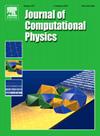Optimal transport-based displacement interpolation with data augmentation for reduced order modeling of nonlinear dynamical systems
IF 3.8
2区 物理与天体物理
Q2 COMPUTER SCIENCE, INTERDISCIPLINARY APPLICATIONS
引用次数: 0
Abstract
We present a novel reduced-order Model (ROM) that leverages optimal transport (OT) theory and displacement interpolation to enhance the representation of nonlinear dynamics in complex systems. While traditional ROM techniques face challenges in this scenario, especially when data (i.e., observational snapshots) are limited, our method addresses these issues by introducing a data augmentation strategy based on OT principles. The proposed framework generates interpolated solutions tracing geodesic paths in the space of probability distributions, enriching the training dataset for the ROM. A key feature of our approach is its ability to provide a continuous representation of the solution's dynamics by exploiting a virtual-to-real time mapping. This enables the reconstruction of solutions at finer temporal scales than those provided by the original data. To further improve prediction accuracy, we employ Gaussian Process Regression to learn the residual and correct the representation between the interpolated snapshots and the physical solution.
We demonstrate the effectiveness of our methodology with atmospheric mesoscale benchmarks characterized by highly nonlinear, advection-dominated dynamics. Our results show improved accuracy and efficiency in predicting complex system behaviors, indicating the potential of this approach for a wide range of applications in computational physics and engineering.

非线性动力系统降阶建模的最优输运位移插值
我们提出了一种新的降阶模型(ROM),该模型利用最优传输(OT)理论和位移插值来增强复杂系统中非线性动力学的表示。虽然传统ROM技术在这种情况下面临挑战,特别是当数据(即观察快照)有限时,我们的方法通过引入基于OT原则的数据增强策略来解决这些问题。提出的框架生成插值解,在概率分布空间中跟踪测地线路径,丰富ROM的训练数据集。我们的方法的一个关键特征是它能够通过利用虚拟到实时的映射来提供解决方案动态的连续表示。这使得在比原始数据提供的更精细的时间尺度上重建解决方案成为可能。为了进一步提高预测精度,我们使用高斯过程回归来学习残差并校正插值快照与物理解之间的表示。我们用大气中尺度基准证明了我们的方法的有效性,这些基准以高度非线性、平流为主的动力学为特征。我们的研究结果表明,预测复杂系统行为的准确性和效率有所提高,表明这种方法在计算物理和工程领域具有广泛应用的潜力。
本文章由计算机程序翻译,如有差异,请以英文原文为准。
求助全文
约1分钟内获得全文
求助全文
来源期刊

Journal of Computational Physics
物理-计算机:跨学科应用
CiteScore
7.60
自引率
14.60%
发文量
763
审稿时长
5.8 months
期刊介绍:
Journal of Computational Physics thoroughly treats the computational aspects of physical problems, presenting techniques for the numerical solution of mathematical equations arising in all areas of physics. The journal seeks to emphasize methods that cross disciplinary boundaries.
The Journal of Computational Physics also publishes short notes of 4 pages or less (including figures, tables, and references but excluding title pages). Letters to the Editor commenting on articles already published in this Journal will also be considered. Neither notes nor letters should have an abstract.
 求助内容:
求助内容: 应助结果提醒方式:
应助结果提醒方式:


